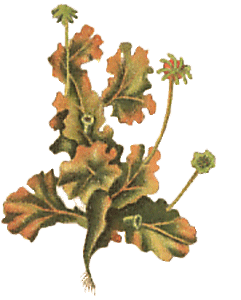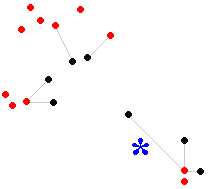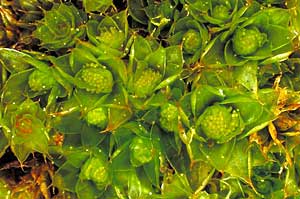
Reproduction & dispersal
Splash cups
Splash cups serve two roles in bryophytes: to disperse sperm or to disperse gemmae. Splash cups are found in only a relatively small number of bryophytes. In some cases the splash cups are very striking and the moss Polytrichum juniperinum is a good example of this. The accompanying photo ![]() shows the splash cups at the apices of male plants of this species. The cups are formed from rings of stiff leaves and the antheridia are located in the centres of the cups, which are about 4 to 5 millimetres in diameter. Sperm, released from the antheridia, accumulate in the cups and any water droplets landing in a cup will eject at least some of the sperm mass within that cup.
shows the splash cups at the apices of male plants of this species. The cups are formed from rings of stiff leaves and the antheridia are located in the centres of the cups, which are about 4 to 5 millimetres in diameter. Sperm, released from the antheridia, accumulate in the cups and any water droplets landing in a cup will eject at least some of the sperm mass within that cup.
How effective is splash-cup dispersal?
One way to answer this question is to do laboratory experiments, by letting drops of dyed water land in splash cups and then see how far away the rebounding droplets land. Experiments of this sort have produced the following maximum observed distances from sperm dispersal cups:
50 cm Mnium ciliare
60 cm Polytrichum ohiense
230 cm Dawsonia superba
It is important to understand that these were the maximum distances. Relatively few rebounding droplets reach those maxima. Most land much closer to the splash cup. Another point about such laboratory experiments is that they are artificial. In the real world there are obstacles such as twigs, rocks and uneven ground. These may block the flight of any ejected sperm.
Another way to study the effectiveness of the splash cup mechanism with regard to sperm dispersal is to look at distributions of female plants with sporophytes and male plants in the field. A plant with a sporophyte is an example of successful fertilization. Sperm has gotten to that plant from somewhere. When you see a sporophyte ask yourself: How close is the nearest male plant of the same species? The sperm that helped produce the sporophyte need not have come from the closest male plant - but it cannot have come from any closer. If you measure the distance between the sporophyte and the nearest male plant, you know the minimum distance the fertilizing sperm must have travelled. Now, look around for another sporophyte and its closest male plant - then another, and another and so on. Measure the distances in each case. The following diagram shows a fictitious scenario. The black dots represent sporophytes and the red dots are male plants. There's a grey line drawn between each sporophyte and its closest male plant. Sometimes a particular male is the closest to more than one sporophyte. The blue asterisk indicates the longest of the distances between a sporophyte and its closest male.

If you were to do this many times, in different areas you would see the sorts of distances the sperm can travel. You would also get some idea of what the maximum possible fertilizing distances are for various species. Here are the observed greatest distances between sporophytes and nearest male plants for several mosses:
2.5 cm Breutelia chrysocoma
5.3 cm Mnium ciliare
11 cm Atrichum angustatum
20 cm Plagiomnium undulatum
75 cm Polytrichum alpestre
380 cm Dawsonia superba (one exceptional case, mostly under 200 cm)
In the thallose liverwort genus Marchantia the antheridia are embedded in saucer-like platforms that are raised on stalks, often a centimetre or two in length. Sperm are released onto the platforms and experiments with water droplets have shown that the sperm can be splashed 40 to 60 centimetres away. In this photo ![]() of a Marchantia colony, viewed from above, you can see a number of star-like antheridial platforms. While sperm may be splashed from splash cups or antheridial platforms it is also likely that sperm are often simply washed, rather than splashed, away. That is likely to be the case during torrential downpours or during heavy runoff.
of a Marchantia colony, viewed from above, you can see a number of star-like antheridial platforms. While sperm may be splashed from splash cups or antheridial platforms it is also likely that sperm are often simply washed, rather than splashed, away. That is likely to be the case during torrential downpours or during heavy runoff.
We started with a photograph of Polytrichum splash cups and we'll finish this discussion of sperm splash cups with another moss, Rosulabryum billardieri. In older references you'll see this species referred to as Bryum billardieri. In this photo you can see numerous yellowish balls within the cup-like structures formed by the apical leaves. The yellow balls are the antheridia on male plants![]() .
.
You'll often see small cup-like structures on the surfaces of liverworts of the complex thallose genus Marchantia ![]() . This is a cosmopolitan genus, with four species in Australia. Within the cups are tiny, greenish disks called gemmae. Each gemma is essentially just an aggregation of cells formed from the parent gametophyte and, when mature, sits loosely in its splash cup (called a gemma cup), from where it is readily dispersed by a water droplet landing within the cup. A gemma cup is only about a half centimetre in diameter. Gemmae are a means of asexual reproduction and a new gametophyte will grow from a gemma that lands in a suitable habitat. The thallose liverwort Lunularia cruciata also has gemma cups, but crescent-shaped rather than circular
. This is a cosmopolitan genus, with four species in Australia. Within the cups are tiny, greenish disks called gemmae. Each gemma is essentially just an aggregation of cells formed from the parent gametophyte and, when mature, sits loosely in its splash cup (called a gemma cup), from where it is readily dispersed by a water droplet landing within the cup. A gemma cup is only about a half centimetre in diameter. Gemmae are a means of asexual reproduction and a new gametophyte will grow from a gemma that lands in a suitable habitat. The thallose liverwort Lunularia cruciata also has gemma cups, but crescent-shaped rather than circular ![]() . It's likely that Lunularia gemmae are more often washed away rather than splashed away.
. It's likely that Lunularia gemmae are more often washed away rather than splashed away.
The northern hemisphere moss Tetraphis pellucida grows in tufts. Gemma-filled splash cups are formed at the apices of upright stems by modified apical leaves. The gemmae can be splashed up to 15 centimetres away![]() .
.
Non-bryophyte splash cups
Splash cups are not confined to bryophytes. A number of organisms have evolved the similar splash-assisted mechanism for dispersal of reproductive propagules. The remainder of this page is devoted to giving a few examples of non-bryophyte splash cups.
Possibly the best-known splash cups are those produced by fungi in the family Nidulariaceae. The fungi in this family are commonly called the Birds Nest Fungi because their fruiting bodies have a superficial resemblance to nests with eggs. In this photo you can see several mature fruiting bodies with their "eggs" (technically called peridioles). The mature fruiting bodies are about a centimetre in diameter. Each peridiole contains numerous spores and the peridioles are ejected when water drops land in the "nests". There's more about peridiole dispersal here.
Lichens in the genus Cladonia often produce small, stiff, stalked cups called podetia. These podetia often contain tiny, granular asexual propagules, with each granule consisting of some fungal hyphae and algal cells. The cups at the tops of the podetia are only a few millimetres in diameter but laboratory experiments have shown that the asexual granules can be splashed up to a metre away by falling water drops. It's worth noting that these lichens do not rely on water since the granules are also dispersed by wind.
Splash dispersal has also been found to be a method of seed dispersal in the following genera of herbaceous flowering plants: Chrysosplenium, Gentiana, Gratiola, Mazus, Mitella, Oenothera, Ophiorrhiza, Sagina, Sedum, Trigonotis and Veronica. Not all species in a genus need have splash-dispersed seeds. In both laboratory and field experiments seed dispersal distance was under a metre![]() .
.
![An Australian Government Initiative [logo]](/images/austgovt_brown_90px.gif)


